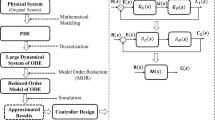Abstract
In this study, a new technique for discrete time system reduction is suggested which preserves the substructure of the higher order system in the reduced system. Motivated by various system reduction and optimization techniques available in the literature, the proposed technique is based on Cuckoo search which is used to obtain unknown elements of the reduced system with an error criterion minimization. The efficacy of the proposed technique is justified by reducing few benchmark systems and the obtained results are compared with other well-known order reduction methods existing in the literature.










Similar content being viewed by others
References
Alsmadi OMK, Abo-Hammour ZS (2015) A robust computational technique for model order reduction of two-time-scale discrete systems via genetic algorithms. Comput Intell Neurosci 2015:1–9
Alsmadi OMK, Abo-Hammour ZS, Al-Smadi AM (2011) Artificial neural network for discrete model order reduction with substructure preservation. Appl Math Model 35:4620–4629
Aoki M (1968) Control of large-scale dynamic systems by aggregation. IEEE Trans Autom Control 13(3):246–253
Bistritz Y (1982) A direct Routh stability method for discrete system modelling. Syst Control Lett 2(2):83–87
Brown CT, Liebovitch LS, Glendon R (2007) Lévy Flights in Dobe Ju/hoansi Foraging Patterns. Hum Ecol 35(1):129–138
Chu YC, Glover K (1999) Bounds of the induced norm and model reduction errors for systems with repeated scalar nonlinearities. IEEE Trans Autom Control 44(3):471–483
Desai SR (2013) Reduced order modelling in control system. Unpublished doctoral dissertation, Indian Institute of Technology Roorkee, Roorkee, India
El-Attar RA, Vidyasagar M (1978) Order reduction by \(L_1\) and \(L_\infty \) Norm minimization. IEEE Trans Autom Control 23(4):731–734
Hutton MF, Friedland B (1975) Routh approximations for reducing order of linear, time-invariant systems. IEEE Trans Autom Control 20:329–337
Hwang RY, Hwang C, Shih YP (1983) A stable residue method for model reduction of discrete systems. Comput Electr Eng 10(4):259–267
Karimaghaee P, Noroozi N (2011) Frequency weighted discrete-time controller order reduction using bilinear transformation. J Electr Eng 62(1):44–48
Moore BC (1981) Principal component analysis in linear systems: controllability, observability, and model reduction. IEEE Trans Autom Control 26(1):17–32
Mukherjee S, Kumar V, Mitra R (2007) Order reduction of discrete systems using step response matching. Int J Model Simul 27(2):107–114
Namratha JN, Latha YH (2015) Order reduction of linear dynamic systems using improved generalise least-squares method and differential evolution algorithm. Int J Eng Res Appl 3(5):95.99
Obinata G, Inooka H (1983) Authors reply to comments on model reduction by minimizing the equation error. IEEE Trans Autom Control 28:124–125
Pal J, Pan S (1992) Controller reduction for discrete time systems. In: Proceedings of international conference on systems science, Wroclaw, Poland, sept. 22-25, pp. 220–224
Pan S, Pal J (1995) Reduced order modelling of discrete-time systems. Appl Math Model 19(3):133–138
Reis T, Stykel T (2008) Balanced truncation model reduction of second-order systems. Math Comput Model Dyn Syst 14(5):391–406
Shamash Y (1974) Stable reduced-order models using Padé-type approximations. IEEE Trans Autom Control 19(5):615–616
Shih YP (1973) Simplification of \(z\)-transfer functions by continued fractions. Int J Control 17(5):1089–1094
Sikander A, Prasad R (2015) Linear time-invariant system reduction using a mixed methods approach. Appl Math Model 39(16):4848–4858
Sikander A, Prasad R (2015) Soft computing approach for model order reduction of linear time invariant systems. Circuits Syst Signal Process 34(11):3471–3487
Sikander A (2016) Reduced order modelling for linear systems and controller design, Ph.D. Thesis. Indian Institute of Technology Roorkee, Roorkee
Singh VP, Chandra D (2012) Reduction of discrete interval systems based on pole clustering and improved Padé approximation: a computer-aided approach. Adv Model Optim 14(1):45–56
Telescu M, Iassamen N, Cloastre P, Tanguy N (2013) A simple algorithm for stable order reduction of z-domain Laguerre models. Signal Process 93(1):332–337
Vasu G, Sandeep G (2012) Design of PID controller for higher order discrete systems based on order reduction employing ABC algorithm. Control Theory Inform 2(4):4–16
Viswanathan GM (2010) Fish in Levy-flight foraging. Nature 465:1018–1019
Yadav JS, Patidar NP, Singhai J (2010) Controller design of discrete systems by order reduction technique employing differential evolution optimization algorithm. Int J Electr Comput Energ Electron Commun Eng 4(1):39–45
Yadav JS, Patidar NP, Singhai J (2010) Model order reduction and controller design of discrete system employing real coded genetic algorithm. Int J Adv Eng Technol I(III):134–144
Yang XS, Deb S (2008) Nature-inspired metaheuristic algorithms. Luniver Press, Bristol
Yang XS, Deb S (2009) Engineering optimisation by cuckoo search. Int J Math Model Numer Optim 1:330–343
Yang X-S, Deb S (2009) Cuckoo search via Levy flights. In: World congress on nature & biologically inspired computing, pp 210–214
Author information
Authors and Affiliations
Corresponding author
Additional information
Publisher's Note
Springer Nature remains neutral with regard to jurisdictional claims in published maps and institutional affiliations.
Rights and permissions
About this article
Cite this article
Ahamad, N., Sikander, A. & Singh, G. Substructure preservation based approach for discrete time system approximation. Microsyst Technol 25, 641–649 (2019). https://doi.org/10.1007/s00542-018-3985-0
Received:
Accepted:
Published:
Issue Date:
DOI: https://doi.org/10.1007/s00542-018-3985-0




